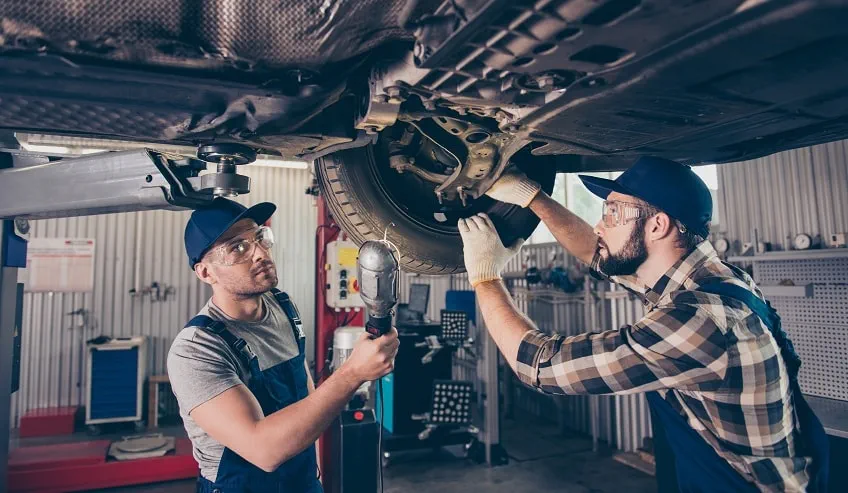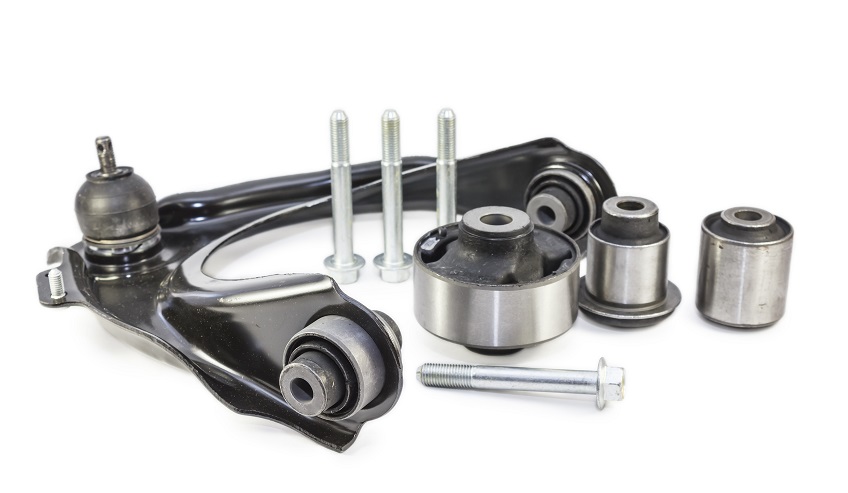
The Glue Talk Blog

How Rubber-to-Metal Bonding Works
Rubber-to-metal bonding plays a crucial role in a wide variety of applications, many of which are in automotive. Some of these applications include anti-vibration components, isolation bushings, suspension dampers, and powertrain mounts. However, bonding rubber to metal doesn’t just happen magically. There’s a unique science at work behind the scenes.
To illustrate, I will focus on rubber-to-metal bonding examples within the automotive industry. Since rubber and metal are dissimilar substrates, each part of the bonding process is critical to a successful and long-lasting connection in anti-vibration components. The process is completely different than bonding rubber to rubber or metal to metal.
In a powertrain mount, for example, the elastomer is connected to a metal part at a “fixture” point by way of an adhesive bonding system. When applied successfully, the elastomer will absorb all energy or vibration, leaving the metal portion of the anti-vibration components to secure the mount to the adjacent frame and powertrain. The connection point and the transference of energy to the elastomer rely on each other because if anything in the process malfunctions, dynamic stress can cause the metal fixture point to rip away from the elastomer. This becomes a warranty nightmare for manufacturers and a serious safety concern for consumers.

CILBOND® Rubber-To-Metal Bonding Agents
For rubber-to-metal or polyurethane-to-substrate bonding H.B. Fuller’s CILBOND® lead-free, one-coat bonding system is a premium solution for the rubber industry. It is an eco-conscious, high-performing system capable of withstanding extreme environmental attacks from chemicals, extreme temperature variation, dynamic stress, and fatigue.
In particular, CILBOND® 24 and CILBOND® 36 one-coat products provide the rubber industry with a versatile solution for nearly every compound type and molding technique—including injection, compression, transfer, and even post-vulcanization.
ONE-COAT and DONE
You don’t have to waste valuable production time waiting for primer to dry with CILBOND because it acts as both primer and topcoat. By eliminating this secondary step, CILBOND’s innovative technology offers increased productivity and decreased costs on anti-vibration systems, tank linings, pipe coatings, rollers, wheels, pulleys, belts, and pumps.
LEAD-FREE
All of our CILBOND products have been lead-free globally for over a decade. This offers our customers reduced health risks and environmental exposure along with the added value of regulatory compliance across the globe. CILBOND combines high-performance with peace of mind when it comes to safety and compliance.
Other Key Benefits include:
- Reduced process costs and increased productivity.
- Improved performance in high-temperature applications.
- Reduced rework and expanded process window.
- Wider range for bonding common and specialty elastomers.
- Enhanced corrosion protection and chemical resistance.
- Extended product life and reliability with a high-performance polymer blend.
In addition to rubber-to-metal one-coat systems, our CILBOND technology offers solutions for friction bonding and polyurethane-to-substrate bonding.
Are you interested in learning more about our CILBOND systems? Meet our experts in person! Visit our Professional Cilbond experts at the International Elastomers Conference on October 8-10 at the Huntington Convention Center of Cleveland.
For samples or to learn more about this cutting-edge technology, send me an email with your bonding challenge.
Blog Categories
Blog Categories
Archive
- 2024
- 2023
-
2022
- February (4)
- March (3)
- April (1)
- May (2)
- June (5)
-
August (6)
- Beverage Labeling Market In Africa: A Huge Potenial
- H.B. Fuller’s Glue House: Scavenger Hunt
- Increasing Global Aging Population: Impacts and Challenges
- Innovations and Key Challenges in Sustainable Disposable Absorbent Hygiene Products
- Supporting Racial Equity in Our Community
- Top 5 Reasons to Invest in H.B. Fuller
- September (4)
- November (2)
- December (2)
-
2021
- January (3)
-
February (7)
- Celebrating Exceptional Service During COVID-19 Complications
- Cyanoacrylates: What They Are and What They Do
- Innovative two-shot bookbinding adhesive
- Make a Difference 2020
- Problem Solving: Paper straws in drinking beverages
- Stronger straws
- Substances of Interest in Disposable Absorbent Hygiene Products
- March (4)
- April (4)
- May (4)
- June (5)
- July (2)
- August (5)
- September (2)
- October (1)
- November (3)
- December (2)
-
2020
- January (4)
- February (2)
- March (3)
- April (4)
- May (3)
-
June (7)
- Community Support in the Era of Coronavirus
- Employee Creates Face Shields with 3D Printer
- Improved Packaging Integrity and Greater Customer Satisfaction
- Liquid-Resistant Paper Straws
- What is a Sealant
- What Is the Future of Commercial Disinfectants
- Winning over consumers with e-commerce packaging solutions
-
July (6)
- Employees Take Action to be Part of Healing and Growth
- Gain a competitive advantage with packaging adhesive solutions
- HB Fuller Company Foundations Commitment to Communities
- Packaging Solutions for the South African Agriculture Market
- Supporting Organizations That Provide STEM Education for Youth
- Where Does Sustainability Stand Amid COVID-19
- August (3)
- September (2)
- October (4)
- November (2)
- December (4)
